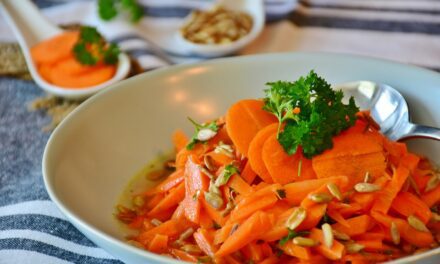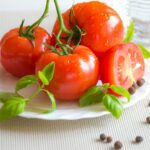Introduction
Iron, a crucial mineral for our bodies, acts like a silent hero, doing essential work to keep us healthy. It works tirelessly to support different jobs inside us, from carrying oxygen to producing energy. Think of it as a behind-the-scenes player that ensures our bodies function at their best. This humble mineral is super important because it helps create hemoglobin, the part of red blood cells that carries oxygen. Without it, oxygen wouldn’t reach every cell and tissue in our body. Iron supports our overall health.
Iron content in veggies
| Food | Iron Content (per 100g) |
| Lentils | 3.3 mg |
| Spinach | 2.7 mg |
| Dry Apricots | 2.7 mg |
| Tofu | 2.7 mg |
| Quinoa | 2.8 mg |
| peas | 1.5 mg |
| Beetroot | 1.1 mg |
| Broccoli | 0.7 mg |
| Baked Potatoes | 0.8 mg |
| Tomatoes | 0.3 mg |
1. Lentils
Lentils, those small but mighty legumes, are a nutritional powerhouse that can elevate your health game. Packed with iron, protein, and fiber, they make a fantastic addition to any diet. Just a cup of cooked lentils delivers a generous 3.3 mg of iron and a hefty 17.86 grams of protein, giving your body the boost it needs.
But the goodness doesn’t stop there. Lentils also come with a squad of essential nutrients like B vitamins, magnesium, potassium, and zinc. It’s like a nutrient party in every bite!
Plus, research suggests that making lentils a regular part of your meals Lentils could help lower the risk of diabetes, obesity, cancer, and heart disease. So, when you’re tossing them into soups, stews, curries, salads, or any other culinary creation, you’re not just treating your taste buds – you’re nourishing your body with a delicious and healthful bite.
2 . Spinach
Spinach not only tastes great but packs a punch in the health department, and the best part? It won’t load you up on calories. In just 3.5 ounces (100 grams) of raw spinach, you get a cool 2.7 mg of iron, making up 15% of your daily value. Now, this iron is non-heme, which means it’s not absorbed super easily, but fear not! Spinach comes to the rescue with a boost from vitamin C, which makes iron absorption way better.
But wait, there’s more! Spinach is like a superhero with its antioxidants called carotenoids. These little wonders not only help in reducing the risk of cancer but also dial down inflammation and act as bodyguards for your eyes.
Here’s a smart trick: When you eat spinach (or any leafy greens), try adding a touch of healthy fat, like olive oil. This makes it easier for your body to grab onto those carotenoids. So, remember to sprinkle a bit of good-for-you fat on your spinach for a tasty and healthy mix. Spinach – making healthy and eating like a piece of cake, super tasty, and full of goodness!
3. Dry Apricot
A cup of dried apricot halves gives you a good dose of iron at 2.7 mg. These dried fruits are not just iron heroes; they’re also packed with fiber, vitamins, minerals, and antioxidants – all the good stuff your body loves. Plus, they make for perfect snacks because you can munch on them easily while on the go.
But, here’s the thing to keep in mind: while dried fruits are nutritious, they can be a bit high in sugar and calories. To avoid gaining weight or dealing with too much sugar, it’s best to enjoy dried apricots in moderation. So, savor the sweetness but don’t go overboard!
4. Tofu
Tofu, a soy-based food loved by many vegetarians and commonly enjoyed in Asian countries, is a nutritional powerhouse.
In just half a cup (126 grams), you get a solid 2.7 mg of iron, making up 19% of your daily needs.
But that’s not all! Tofu brings more goodies to the table – it’s a rich source of thiamine, a vitamin that’s good for your body. It also has essential minerals like calcium, magnesium, and selenium. Plus, it packs a punch with 22 grams of protein in each serving.
What makes tofu even more impressive are the special compounds it contains called isoflavones. These little wonders have been linked to better insulin sensitivity, a reduced risk of heart disease, and helping with to imbalance of your hormones.
So, whether you’re a vegetarian or just a fan of tasty and nutritious eats, tofu is like a superstar in the world of good-for-you foods!
5. Quinoa
Quinoa is a cool grain that’s often called a “pseudocereal.” It’s not your typical cereal, but it’s just as awesome.
A half cup of quinoa contains 2.8 mg of iron.
And here’s a bonus – quinoa has no gluten. That’s good news for dealing with slow immune system disease or those who can’t handle gluten in their diet.
Quinoa doesn’t just stop at being gluten-free; it’s also a protein powerhouse, meaning it has lots of the good stuff your body needs. Plus, it’s packed with nutrients like folate, magnesium, copper, manganese, and more.
Here’s the extra cool part: quinoa is like a superhero against cell damage because it’s full of antioxidants. These antioxidants act like shields, protecting your cells from the bad stuff caused by free radicals – those tricky troublemakers that show up during metabolism and stress.
So, whether you’re after a gluten-free option, a protein boost, or just a super healthy meal, quinoa is your go-to grain!
6. Peas
A cup of peas packs roughly 1.5 to 2 milligrams of iron
Peas, often overlooked, are nutritional powerhouses vital for well-being. These tiny green wonders not only add flavor to meals but also play a crucial role in a balanced diet. Rich in iron, essential for energy and oxygen transport, peas are a must on our plates. Regular inclusion meets daily iron needs, supporting overall health and preventing deficiency.
Peas are particularly beneficial for cardiovascular health. The rich combination of nutrients in peas, including fiber, antioxidants, and vitamins, contributes to heart health by supporting lower cholesterol levels and promoting overall cardiovascular well-being. Including peas in your diet can be a tasty way to nurture your heart and maintain a healthy cardiovascular system.
7. Beetroot
Beetroots, those vibrant roots from the Beta vulgaris family, are more than just a burst of color—they’re a nutritional powerhouse offering numerous benefits. Loaded with vital nutrients such as fiber, folate (vitamin B9), manganese, potassium, iron, and vitamin C, beetroots play a significant role in creating a balanced and healthy diet. These root veggies have been associated with various health advantages, including promoting heart health, reducing blood pressure, and enhancing exercise performance, all thanks to their rich inorganic nitrates. Whether you enjoy them for a satisfying crunch when raw or prefer them cooked and pickled for added versatility, beetroots bring a delicious dimension to your meals. Don’t forget the extra goodness of beet greens; those leafy companions are entirely edible. When it comes to varieties, beetroots paint a colorful palette with shades of yellow, white, pink, and the classic dark purple. Plus, let’s highlight the importance of iron in beetroots—a crucial mineral for overall well-being. To put it in perspective, beetroots contain around 1.1 mg of iron per 100 grams, making them not only tasty but also a great source of this essential nutrient for your plate.
8. Broccoli
Broccoli is super healthy. If you have a cup of cooked broccoli (that’s about 156 grams), you get 1 milligram of iron, making up 6% of what you need in a day.
But here’s the cool part: that same cup of broccoli gives you a whopping 112% of the vitamin C you need daily. And guess what? Vitamin C helps your body grab onto that iron even better.
And it doesn’t stop there – this serving of broccoli is loaded with other good stuff like folate, giving you 5 grams of fiber, and a bit of vitamin K. Broccoli is part of the cruciferous veggie family, hanging out with cool members like cauliflower, Brussels sprouts, kale, and cabbage
Broccoli is super healthy. If you have a cup of cooked broccoli (that’s about 156 grams), you get 0.7mg of iron, making up 6% of what you need in a day.
But here’s the cool part: that same cup of broccoli gives you a whopping 112% of the vitamin C you need daily. And guess what? Vitamin C helps your body grab onto that iron even better.
And it doesn’t stop there – this serving of broccoli is loaded with other good stuff like folate, giving you 5 grams of fiber, and a bit of vitamin K. Broccoli is part of the cruciferous veggie family, hanging out with cool members like cauliflower, Brussels sprouts, kale, and cabbage.
Now, what makes these veggies extra special are some fancy plant compounds like indole, sulforaphane, and glucosinolates. Scientists think these compounds might help shield your body against cancer. So, broccoli isn’t just tasty – it’s like a little health superhero on your plate!
9. Baked Potatoes
Potatoes, especially when you keep the skin on, are a fantastic way to add iron to your diet. A medium-sized potato with its skin can provide you with 0.8 mg of iron, which is pretty good for your health.
Now, beyond just the iron boost, potatoes are like the quiet heroes of the food world. They’re not only basic things in many cultures but also bring a bunch of healthy goodies to the table. Think carbs for energy, dietary fiber for a happy tummy, resistant starch for gut health, vitamin C for a little immune system love, and potassium for a healthy heart.
For a complete and delicious meal, try topping baked potatoes with things like cottage cheese, hummus, beans, or lentils. So, when you have potatoes in different yummy ways, it’s like having a little party of flavors in your meal.
But hey, a quick tip – go easy on the butter, oil, or cheese you add because too much can pile up the fat and calories in your meal. Keep it tasty and healthy!
10. Tomatoes
Tomatoes aren’t known for being iron-packed, they quietly contribute to your daily iron needs. In about 100 grams of tomatoes, you’ll find around 0.3 mg of iron – not as much as some iron-rich foods, but here’s the cool part – tomatoes offer more than just iron. Filled with antioxidants, vitamins, and minerals, they’re like a health hero in disguise, supporting your overall well-being. Tossing tomatoes into your meals not only brings a burst of flavor but also gives a little lift to your iron intake, helping you maintain a balanced and nutritious diet.
So, the next time you enjoy a fresh tomato salad or a bowl of pasta with a rich tomato-based sauce, know that you’re not just pleasing your taste buds; you’re also giving your body a sprinkle of nutritional goodness.
Conclusion
In the world of nutrition, these iron-rich foods showcase not only their impressive iron content but also a multitude of health benefits. Iron, a silent hero, plays a crucial role in oxygen transport and energy production. Lentils lead with 3.3 mg of iron, a protein and fiber powerhouse. Quinoa offers gluten-free goodness and 2.8 mg of iron. Spinach, rich in 2.7 mg of iron, acts as a superhero with carotenoid antioxidants. Tofu provides 2.7 mg of iron, essential minerals, and isoflavones. Dried apricots showcase portability and 2.7 mg of iron. Peas, with 1.5 to 2 mg of iron, are crucial for cardiovascular health. Broccoli’s modest 1.1 mg of iron is boosted by vitamin C. Baked potatoes offer 0.8 mg of iron, dietary fiber, and vitamins. Tomatoes contribute 0.3 mg of iron, along with antioxidants and vitamins. Each bite is a step toward a balanced, nourished life with a delightful journey of taste.













Recent Comments